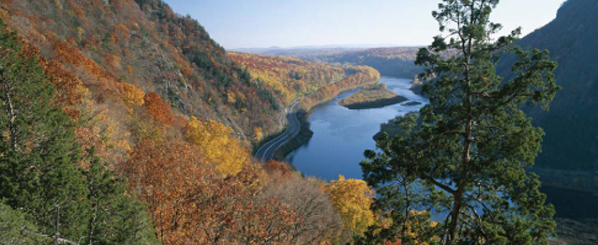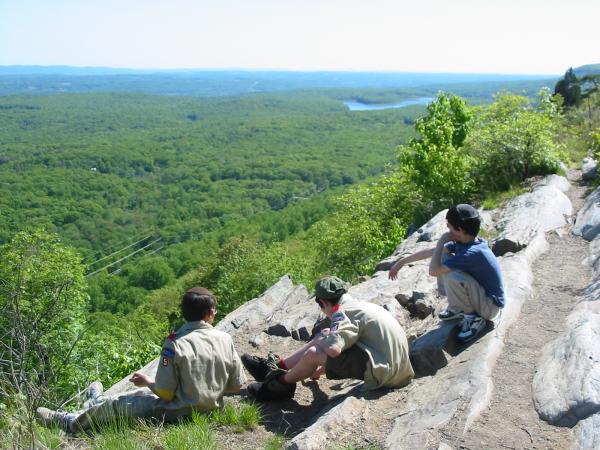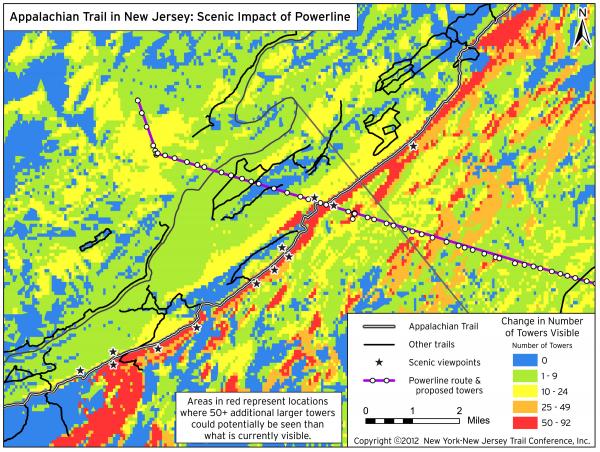
PSE&G's 45-mile long Susquehanna-Roseland electric line will be built along an existing transmission route and is planned to pass through 15 different New Jersey municipalities. New transmission towers would be built next to the current 80 foot towers, but the new towers would rise to heights of almost 200 feet. The route of the proposed 500-kilovolt electric line will cut right through one of the state's most precious resources-the 860,000 acre Highlands Region as well as the Delaware Water Gap National Recreation Area (pictured above) and the Appalachian Trail.
The Trail Conference opposes this powerline plan because of the devastating impact it would have on trails, open space, and views across New Jersey.
September 9, 2013: The coalition, including the Trail Conference, that sued to stop PSE&G's construction of the Susquehanna-Roseland powerline project through the Delaware Water Gap National Recreation Area will not appeal the judge's decision. The court concluded that the agency did not act arbitrarily and capriciously. The chance for a successful appeal of the decision was judged to be minimal. Info about the construction schedule is to be posted at http://www.nps.gov/dewa/parkmgmt/power-line-updates.htm and http://www.pseg.com/family/pseandg/powerline/index.jsp
September 4, 2013: Federal Judge Richard Roberts declined arguments by the National Parks Conservation Association and nine other environmental groups that sought to halt construction of the Susquehanna-Roseland project through the Delaware Water Gap National Recreation Area and two adjoining federal recreation sites.
August 19, 2013: Powerline opponents today filed a renewed motion for a preliminary injunction asking for a stop to the imminent construction in the parks. The government and companies now have 7 days to respond. Click for story in NJ Herald.
August 17, 2013: Groups File PSE&G Says Work to Start at Delaware Water Gap Sept. 3
June 24, 2013 News Item: Park Service, utilities defend power line decisions
June 14, 2013 News Item: Lawsuit alleges feds illegally agreed to power-line project
December 20, 2012: Power line work underway
December 6, 2012: Conservation Groups Move to Stop Power Line Construction Before Irreversible Damage Is Done
October 16, 2012: Power line construction schedule for fall announced
October 15, 2012: Conservation Groups Challenge Power line Approval by National Park Service
October 3, 2012: Federal officials give final OK to powerline
September 30, 2012: National Park Service power line decision could come as early as Oct. 1
September 27, 2012: Trail Conference analysis maps visual impact of power lines on historic Appalachian National Scenic Trail.
June 18, 2012: New Jersey regulators approve $390 million PSE&G transmission project
March 28, 2012: National Park Service Gives OK to Power Line through Three National Parks
The Trail Conference is very disappointed by the National Park Service decision to support the proposed routing of the Susquehanna-Roseland power line through the Delaware Water Gap and across the Appalachian Trail. The park service is expected to release a final environmental impact statement on the project in August, followed by another public comment period. The final decision is to be released on Oct. 1.
The following statement was issued by the National Park Conservation Association Senior Vice President for Policy Ron Tipton:
“Today’s announcement by the Obama Administration of the National Park Service’s (NPS) “preferred alternative” to allow massive 200-foot towers and power lines across the Delaware Water Gap National Recreation Area, the Middle Delaware National Scenic River, and the Appalachian National Scenic Trail in New Jersey and Pennsylvania is extraordinarily disappointing.”
“The public utilities, PSE&G and PPL, have stated that they would purchase sensitive lands surrounding the parks as mitigation for the damage from massive power lines through the mid-section of one of the 10 most visited national park sites in the country. This development can only harm visitors’ experience to the parks, many of whom travel from nearby densely populated urban areas seeking inspiring views and outstanding recreational opportunities, and puts economic benefits that the parks provide to local communities at risk as well.
“It is unfortunate that the Obama Administration is not considering other proven alternative technologies such as superconductor pipe lines or advanced cable technologies to avoid the impairment of park resources. Investing in alternative technologies could potentially improve park viewsheds. Since PSE&G and PPL are willing to spend millions of dollars on surrounding lands to mitigate the impacts that their power lines will cause through three national parks, it makes no sense for the NPS and the utility companies to not consider mitigating the direct impact itself. We believe today’s proposal would clearly violate the National Park Service Organic Act of 1916, which mandates the agency to “conserve the scenery” from impairment.
“America’s national parks are treasured places and we need to keep them that way. If the NPS allows 200 foot power lines to degrade these three park sites, what parks will be next? We encourage the Administration to avoid America’s national parks when siting transmission lines – this will ensure future generations can enjoy national parks as visitors do today. Meeting energy needs is an important priority, but not at the expense of our national parks.”
JANUARY 31, 2012
Deadline for Comments on Draft Environmental Impact Statement
Make sure your voice is heard!
The National Park Service needs broad public support to select the "NO BUILD Alternative" (Alternative #1) as the NPS-preferred Alternative. With public support, they will be able to stop the construction of this line through the Delware Water Gap.
Top Points to Make in Your Comments:
- The NPS must select the NO BUILD alternative (Alternative #1) as the "NPS-preferred alternative."
- All action alternatives will result in an impairment of Park resources and greatly detract from the overall enjoyment of this protected land.
Speak out against the line at all upcoming hearings: NO BUILD! Tell NPS how this project will impact your experience at the parks. Talk about how your ability to enjoy hiking, fishing, boating etc. will be impacted by ruined views and park/road construction closures. Any "build" alternative has unacceptable, unnecessary, and permanent impacts on Park resources. The mitigation plans do not do enough, and more alternatives must be included.
Tuesday, January 24, 2012 - 6pm
Fernwood Hotel and Resort, US 209, Bushkill, PA 18324
Wednesday, January 25, 2012 - 6pm
Stroudsmoor Country Inn, RD #4 Stroudsmoor Rd, Stroudsmoor, PA 18360
Thursday, January 26, 2012 - 6pm
Farmstead Golf and Country Club, 88 Lawrence Rd, Lafayette, NJ 07848
SUBMIT COMMENTS ONLINE http://parkplanning.nps.gov/commentForm.cfm?documentID=44314
* * *
September 14, 2010
Deadline for Comments on Preliminary Alternatives
Trail Conference requests that NPS take the "No Action" Alternative (Alternative #1).
July 30, 2010
National Park Service Releases New Set of Powerline Alternatives
Click here to read NPS newsletter.
March 12, 2010
Appalachian Trail Conservancy comments to NPS. Click here.
February 17, 2010
Trail Conference Comments to NPS on PSE&G Plan. Click here for comments.
February 16, 17, 18
National Park Service scoping hearings set; first step in preparing Environmental Impact Statement. Click here for meeting details and suggested talking points.
February 11, 2010
NJ Board of Public Utilities Approves Project
BACKGROUND
The project's approval process includes:
The New Jersey Board of Public Utilities: must give initial approval of the project (it did 2/11/10)
The National Park Service: must prepare an Environmental ImpactStatement on the project's iimpact on the Delaware Water Gap NationalRecreation Area and the Appalachian Trail, a unit of the NPS
The NJ Dept. of Environmental Protection: must decide if the electric line can be built through the Highlands Preservation area.
---------------------------------------------------------------------
Trail Conference Viewshed Analysis of entire Route B corridor
* Viewshed map 1 showing visual impact of current electric towers
* Viewshed map 2 showing visual impact of proposed towers
* Viewshed map 3 showing increase in visual impact only
* Map explanation
These maps were submitted to the NJ DEC and NJ Highlands Council as each decides whether to allow the project to move forward in the preservation and conservation areas respectively.
Description & History
 |
The powerlines visible in the lower left of the photo will be doubled in height and the corridor widened should the PSE&G plan be built. |
PSE&G's 45-mile long Susquehanna-Roseland electric line will be built along an existing transmission route and is planned to pass through 15 different New Jersey municipalities. New transmission towers would be built next to the current 80 foot towers, but the new towers would rise to heights of almost 200 feet. The route of the proposed 500-kilovolt electric line will cut right through one of the state's most precious resources-the 860,000 acre Highlands Region.
PSE&G says the higher towers are designed to minimize electric and magnetic fields, and the proposed route minimizes the amount of vegetation that would have to be cut and crosses the smallest amount of forests and wetlands. The company says the $750 million line, scheduled for completion by 2012, is needed to avoid future power outages. Environmentalists and local municipalities disagree and believe the proposed transmission line poses many questions that must be answered before the project can begin to move forward.
PSE&G originally intended to work individually with each of the 15 municipalities that will host the transmission line. However, after much resistance from the municipalities and environmental groups, PSE&G changed its strategy and is now going directly to the New Jersey Board of Public Utilities and bypassing the municipalities altogether. This move has further outraged both the municipalities and the environmental groups that are vehemently questioning the need for this electric transmission line.
Because the PSE&G project traverses New Jersey's Highlands Region, the NJ DEP will need to determine whether or not to grant a special exemption for the transmission line.
The request would necessitate widening the existing right-of-way and constructing new access roads on National Park Service lands. The expanded line and new towers will impact three units of the National Park Service: the Delaware Water Gap National Recreation Area (DEWA); the Middle Delaware National Scenic and Recreational River and National Recreation Water Trail; and the Appalachian National Scenic Trail (AT).
LINKS
National Park Service: Page for Powerline EIS Study
PSE&G's Susquehanna-Roseland Project page
Dear National Park Service Planning Team,
Please choose Alternative #1 "No Action" with respect to the Susquehanna to Roseland 500kV Electric Transmission Line.
The Delaware Water Gap National Recreation Area has been preserved for the public to enjoy its scenic beauty. Given that the public need for the power line has not been demonstrated, allowing any despoliation of the DWGNRA is not warranted. To do so, would be to degrade the economy and quality of life in this region.
Thank you for choosing Alternative #1 "No Action."


Comment: Please be relevant, civil, non-commercial.
Power Line Comment
I really have a problem making a firm stand for or against the PSE&G Electric Power line going thru the NPS property. Yes, I would not like to see more towers and more trees cut down, new dirt roads (which bring in ATVs) etc. But I also want to turn my lights on when ever I want l. I do not want to pay larger rates because we force the utility to use some expensive technology or routing change that would require them to spend millions to purchase additional right of way and more expense because it is not a direct route.